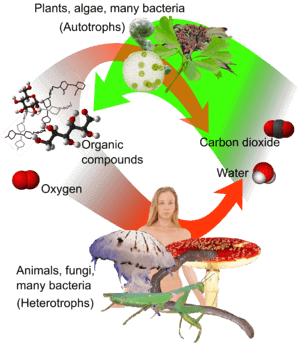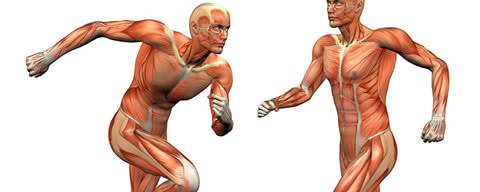The process of respiration can take place in the presence as well as absence of oxygen. Hence, respiration is of two types:
1. Aerobic respiration and
2. Anaerobic respiration
Aerobic respiration
The respiration which takes place in the presence of oxygen is called aerobic respiration. In aerobic respiration food (glucose) is completely broken down into carbon dioxide and water by oxidation of food. This result in the production of a large amount of energy which is stored in the form of ATP (Adenosine TriPhosphate) molecules. It should be noted that 1 molecule of glucose produces 38 high energy molecules of ATP during aerobic respiration takes place both in cytoplasm and in the mitochondria of a cell. Aerobic respiration can be written in the form of chemical equation as:
C6H12O6 + 6O2 → 6CO2 + 6H2O + Energy
During aerobic respiration 1 mole of Glucose produces 2830 Kilojoules of energy.
Anaerobic respiration

The respiration which takes place in the absence of oxygen is called anaerobic respiration. This type of respiration is found commonly in microorganisms such as yeast and bacteria. In microorganisms the term fermentation is more commonly used in place of anaerobic respiration. Fermentation may be defined as the anaerobic breakdown of carbohydrates and other organic compounds into ethyl alcohol, carbon dioxide or lactic acid. For example, fermentation of sugar is done by yeast. Actually yeast produces two enzymes called invertase and zymase which break down carbohydrates anaerobicaly in ethyl alcohol and carbon dioxide. The chemical equation for this can be written as:
C6H12O6 → 2C2H5OH + 2CO2 + Energy
During anaerobic respiration only 2 ATP molecules are produced thus anaerobic respiration produces less energy as compared to aerobic respiration. 1 mole of glucose produce 118 Kilojoules of energy during anaerobic respiration.

Anaerobic respiration also takes place in our muscles during vigorous exercise, because they do not get as much oxygen as is used up. During this process, muscles produce lactic acid from glucose. This results in pain in muscles. The breaking down of glucose in lactic acid during anaerobic respiration can be represented as follow:
Glucose → Lactic acid + Energy
Test Your Understanding and Answer These Questions:
- What is ATP? What is its function?
- What are different types of respiration?
- What is aerobic and anaerobic respiration?
- What are the end products of aerobic respiration?
- What are the end products of anaerobic respiration?
- In which kind of respiration more energy is produced.
- Give differences between aerobic and anaerobic respiration.
- Write names two microorganisms which respire anaerobicaly.
- What is fermentation? What is the role of yeast in fermentation?
- Give differences between anaerobic respiration and fermentation.
- Which gas is taken in and released out during the process of respiration?
- How much energy is produced from 1 mole of glucose in aerobic respiration?
- How much energy is produced from 1 mole of glucose in anaerobic respiration?
